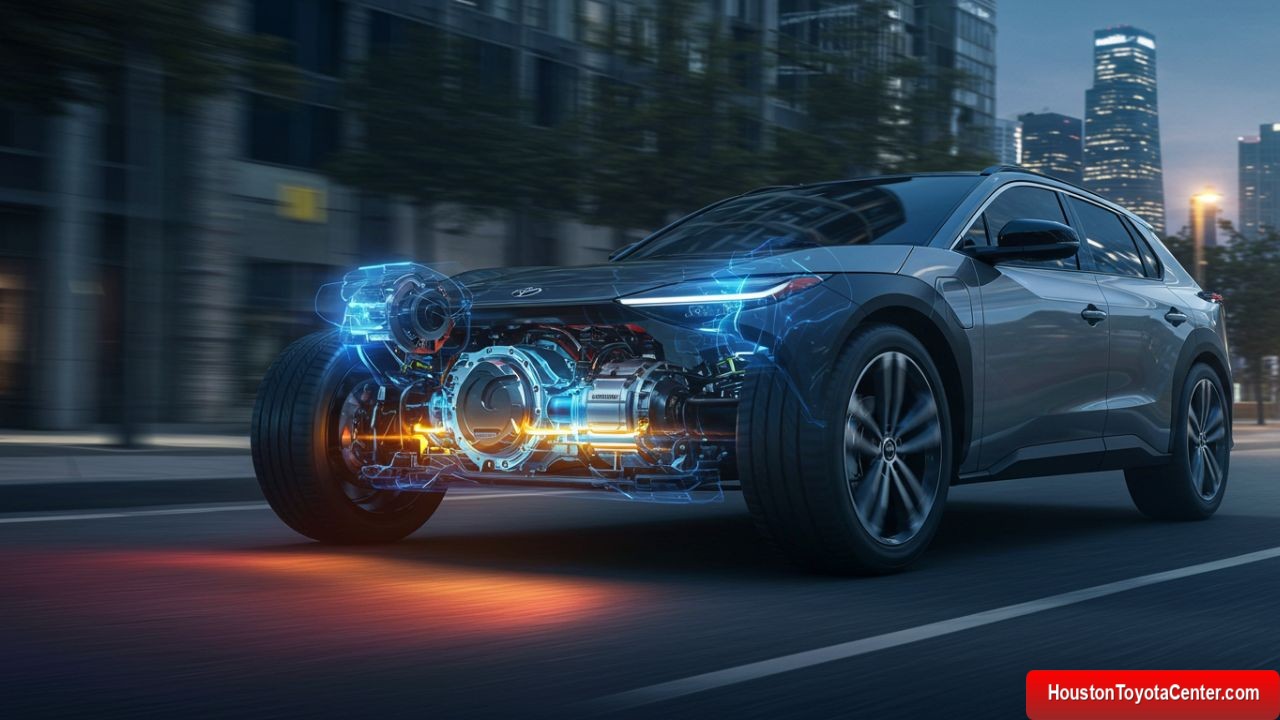The world of automotive engineering is undergoing a seismic shift. As electric vehicles (EVs) surge in popularity, automakers are being challenged to innovate at every level — and Toyota is answering that challenge with its revolutionary eAxle technology, a cornerstone of its all-electric SUV, the Toyota bZ4X.
This article dives deep into what eAxle is, how it powers the bZ4X, and why it’s a game-changer in the world of electric mobility. Whether you’re an EV enthusiast, a tech-savvy consumer, or simply curious about Toyota’s latest innovations, you’ll find everything you need to know about this cutting-edge propulsion system right here.
What Is Toyota’s eAxle Technology?
At its core, eAxle (Electric Axle) is a fully integrated drive module that combines three essential EV components:
- Electric motor
- Inverter
- Transaxle (reduction gear)
These components are typically spread throughout traditional electric vehicle powertrains. But with eAxle, they’re consolidated into one compact unit. This results in a cleaner, more efficient design that simplifies assembly, reduces weight, and maximizes interior space.
FREE: Quickly identify and understand problems with your vehicle 🚘
CLICK HEREKey Functions of the eAxle:
- Delivers power directly to the wheels
- Reduces mechanical complexity
- Improves energy efficiency and range
- Allows modular integration in FWD, RWD, and AWD configurations
Toyota’s eAxle was co-developed with Aisin Corporation and Denso Corporation, combining decades of mechanical and electronics experience.
How the eAxle Powers the Toyota bZ4X
The Toyota bZ4X — the first vehicle on Toyota’s e-TNGA (Toyota New Global Architecture for electric vehicles) platform — relies on the eAxle system to create a smooth and responsive driving experience.
Two Configurations:
| Drive Type | Motor Location | Power Output |
|---|---|---|
| FWD | Front eAxle | 150 kW |
| AWD | Front + Rear eAxles | 80 kW (each) |
The front-wheel drive (FWD) version uses a single high-output eAxle at the front, while the all-wheel drive (AWD) variant uses dual eAxles, one at each axle, for superior traction and balance.
This setup offers dynamic torque distribution and regenerative braking functionality, enhancing both driving performance and energy recovery.
eAxle Advantages Over Traditional EV Systems
Let’s explore why the eAxle system gives Toyota a competitive edge:
✅ Compact Design
Traditional EVs often spread components throughout the vehicle. Toyota’s eAxle bundles them together, freeing up space for more passenger room and battery capacity.
✅ Modular Flexibility
The eAxle can be easily adapted for FWD, RWD, or AWD layouts — making it an excellent choice for Toyota’s upcoming electric vehicle lineup.
✅ Better Weight Distribution
By placing the entire motor-transaxle-inverter unit close to the wheels it powers, the eAxle lowers the center of gravity, improving stability and handling.
✅ Greater Efficiency
With fewer mechanical linkages and better thermal management, energy loss is minimized. This results in longer range per charge and improved battery performance.
eAxle vs Conventional EV Drivetrains
Here’s a direct comparison between Toyota’s eAxle system and conventional EV systems:
| Feature | Traditional EV Powertrain | Toyota eAxle System |
|---|---|---|
| Component Integration | Separate motor, inverter, gearbox | Integrated into one unit |
| Packaging | Bulky and space-consuming | Compact and space-saving |
| Weight | Heavier | Lighter |
| Thermal Efficiency | Lower due to dispersion | High, with integrated cooling |
| Modularity for Different Drivetrains | Limited | Highly adaptable |
Performance Benefits in the Toyota bZ4X
Let’s focus on the real-world benefits of eAxle in the Toyota bZ4X:
⚡ Instant Torque Delivery
The electric motor’s position in the eAxle allows for rapid torque transfer — crucial for EVs aiming for zero-lag acceleration.
🌀 Smoother Ride
The optimized design reduces mechanical vibration and noise, making the cabin experience quiet and refined.
🏞️ Better Off-Road and All-Weather Capability (AWD Model)
The dual eAxle setup offers precise torque distribution, which is particularly beneficial when tackling rough terrain or slippery roads.
Thermal Management and Longevity
EV systems often struggle with overheating, which reduces performance and lifespan. Toyota’s eAxle incorporates advanced cooling systems, including:
- Integrated water-cooled jackets
- Efficient thermal routing between inverter and motor
- Optimized heat sinks
This keeps the system within an ideal temperature range, even under demanding conditions, increasing both reliability and battery longevity.
Sustainable Manufacturing of eAxle Units
Toyota emphasizes sustainability not only in driving emissions but also in how the bZ4X and its components are made.
The eAxle is manufactured with:
- Reduced rare-earth materials in the magnets
- Highly recyclable metals and polymers
- Automated precision assembly, reducing waste
This makes the bZ4X one of the most environmentally conscious vehicles Toyota has ever produced.
Future of eAxle Technology in Toyota Vehicles
The bZ4X is just the beginning of Toyota’s all-electric roadmap. Upcoming vehicles in the bZ (beyond Zero) series and even performance models will benefit from variations of this technology.
Toyota’s modular eAxle design ensures that it can be scaled up for trucks and SUVs or optimized for range-focused sedans.
Expected Future Models with eAxle:
- bZ3X — Compact crossover
- bZ5 — Larger SUV with dual-motor AWD
- Lexus EVs — Premium variants with performance-tuned eAxles
Challenges and Industry Comparisons
Though Toyota’s eAxle is innovative, it’s not the only player. Other automakers are exploring similar technologies:
| Brand | eAxle Equivalent | Notable Vehicles |
|---|---|---|
| Tesla | Drive Unit | Model 3, Model Y |
| Hyundai/Kia | Integrated Drive Axle | IONIQ 5, EV6 |
| GM | Ultium Drive | Cadillac Lyriq, Hummer EV |
| Ford | Integrated Power Unit | Mustang Mach-E, F-150 Lightning |
Toyota’s strength lies in efficiency, reliability, and scale, offering a balance between performance and longevity that few competitors can match.
Real-World Driver Impressions
Drivers of the bZ4X report:
- Silky-smooth takeoffs due to instant torque from the eAxle
- Confident handling in snowy or rainy conditions (AWD variant)
- More cabin room, thanks to compact component packaging
- Quieter drives, even at highway speeds
These impressions show that the tech isn’t just impressive on paper — it translates into real comfort and confidence on the road.
Conclusion: Why eAxle Is the Heart of Toyota’s EV Evolution
Toyota’s eAxle technology is a milestone in the evolution of EV architecture. It’s not just about powering the bZ4X — it’s about redefining what’s possible in electric mobility.
By consolidating essential drivetrain components into a single, efficient, and scalable unit, the eAxle enables:
- Greater performance
- Better efficiency
- Smoother driving experience
- Flexible applications across multiple vehicle types
The bZ4X stands as a testament to Toyota’s commitment to innovation, sustainability, and driving pleasure. As the automotive world moves toward electrification, Toyota’s eAxle proves that the future can be not only greener, but smarter and more exciting, too.


Leave a Reply